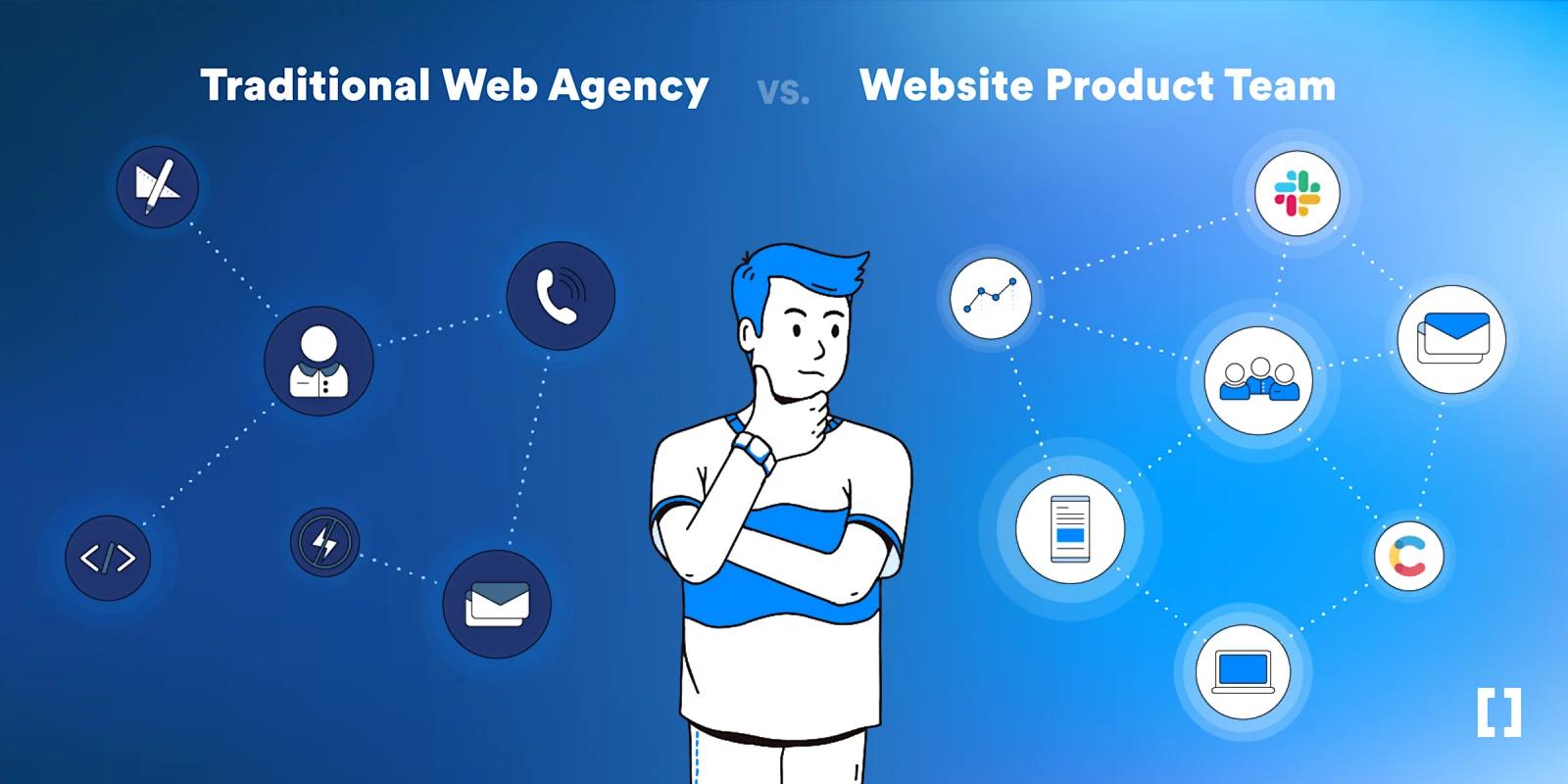When teams are looking for a digital solution, more often than not they will hire a digital agency to take care of it. A digital agency typically has several service offerings from marketing and Search Engine Optimization to design and web development.
The tricky part is when digital agencies fail to be scalable. They could have the best in-house design team but poor project management and workflows. To make matters worse, their communication channels are closed off.
These types of agencies are stuck in the last decade. You’d think that web development agencies would have extensive communication with their clients, but that’s not always the case. We put together 9 reasons why traditional web agency models don’t scale, and what you can do to ensure you’re working with a team that can help you grow.
What Do We Mean by "Traditional Web Agency?"
A traditional agency is an organization of people that provides a particular service between two parties. For example, a web development agency is a middleman between a client needing development services and a team of web developers.
Unfortunately, with so many agencies in existence today, the agency model has acquired somewhat of a stigma for being an expensive, slow, and poor experience.

Web-agency-work-space
This stigma has high-growth technology startups shying away from working with agencies, and instead try to leverage their existing engineering resources.
Neither are good options and here's why:
- Traditional agencies have a fatal flaw in their design structure and process.
- Because product engineering always takes priority over website development.
In this article, we'll explore 9 areas traditional agencies fail to meet the growing demands of today's fastest-growing startups and present an alternative model known as website product teams to detail how startups can have the best of both worlds.
Before we discuss the reasons, let's define what a website product team is.
What is a Website Product Team?
A website product team uses an embedded team model to work directly with marketing, sales, brand, and customer success teams in an agile format to ensure all website operations and marketing needs are running smoothly with zero downtime.
The product team at your SaaS company only focuses on maintaining, updating, and expanding your products. Our product is your website.

web-team-strategizing
Your website is your primary growth surface, first touchpoint, and 24/7 salesperson. By prioritizing your web and marketing operations, you can ensure your brand is attracting, converting, and building trust with prospective consumers all the time.
Now that we've established common ground, let's explore 9 reasons why traditional agencies are falling behind website product teams.
9 Shortcomings of Traditional Web Agencies
1. Account Managers are Bottlenecks
Agencies typically employ several Account Managers (AM) responsible for managing the ongoing business relationship between the agency and their client.
Being an AM is no easy task. Why? Because being the liaison between client needs and internal design, development, or marketing departments is not efficient.
Remember the game telephone? One person starts with a message that is then passed down a line of people, and the phrase is revealed by the last person. In most games, when the message reaches the last person, it is completely distorted.
Similarly, information gets lost in translation when it flows through Account Managers.
The Solution:
The individual contributors in the agency (e.g., developers, designers, marketing technologists, etc.) interface directly with the client stakeholders (e.g. marketing director, director of lead generation, content managers, etc.) every day for a short meeting.
By creating a space for clients to share needs directly with the team implementing them, there is less room for information lost in translation, and website product teams promote a culture of transparency and collaboration within the client’s organization.
In the end, open channels of communication help increase speed to market, improve client satisfaction, and make agency-client relationships more productive.
2. Jack of All Trades, Master of None
Traditional agencies typically offer a suite of services (e.g. branding, web development, paid media, etc.). Having several service offerings allows agencies to attract prospects looking for an end-to-end solution, however, an agency can't be everything to everyone.
The Solution:
Lean into your strongest service and build the team to support demand for tertiary services as your existing relationships grow. By redoubling efforts on what works, and only expanding as necessary, you focus all of your resources on delivering best-in-class service, scaling vertically, and avoid the risk of stretching your team too thin.
3. Outdated Tech Stacks
Companies with the best technology win. It's that simple.
A tech stack is the collection of technologies a company uses to run their company: from web operations to marketing, sales, ticketing, and customer success.

tech-stack-stickers
If you've been in business for any considerable amount of time, you know how difficult and time-consuming it can be to adopt new technology. The same is true for traditional agencies when they recommend cookie-cutter solutions for every new client.
If you're a startup with enterprise ambitions, you shouldn't settle for anything less than a headless CMS. It is undeniably the fastest, most scalable web solution. If an agency you're evaluating recommends anything different, find another partner to work with.
When traditional agencies recommend older technology, today's startups miss out on the added benefits of technology working together through modern integrations. There is no reason your website, CRM, data enrichment, and product analytics tools shouldn't be able to share data in 2021.
The Solution:
Website product teams focus on building with the best technology stacks to give clients every possible competitive advantage. From leveraging headless CMS platforms like Contentful with modern frontend frameworks like Gatsby.js to data enrichment and product analytics tools like Segment and FullStory, website product teams know how to integrate technology to give marketing organizations the freedom they need to grow their brand.
Pair a lightning-fast website and clear customer data with a scalable marketing automation tool like HubSpot, and your company's team is set to scale.
4. Outdated Design Systems
Traditional web design agencies stay in their comfort zone by purchasing website design templates that offer 80% of the features their client needs out-of-the-box and customizes the remaining 20% to fulfill their scope of work.
Not only does this restrict the full potential of a growing brand, but companies who rely on this approach are failing to stay on top of new design trends.
The Solution:
With the emergence of blockchain technology, we're seeing a parallel transition from Web 2.o design to futuristic, Web 3.0 web design systems.
Today's best website development companies are creating scalable design systems, 3D graphics, and using modern layouts to take advantage of any edge possible.
Because Web3 is an emerging design movement today, it is more likely today's top startups will look to development firms that have a track record with developing web experiences that align with UI/UX best practices.
Related Reading: Developing Ocelot's headless WordPress website with Gatsby.js
5. Outdated Communication Tools
Tomorrow's Fortune 500 companies are today's venture capital-backed startups.

slack-app-laptop
Because of their bold KPIs and top-down growth targets from their investors, these startups have to always be accelerating, and avoid as many pitstops as possible.
Unresponsive teams during urgent situations or periods of intense growth directly impact a startup's bottom-line, ability to hit key milestones, and reach the next round of funding. With so much on the line, agencies need to be as responsive as possible.
Traditional agencies typically rely on email for their client communications. Now there's nothing wrong with this, but email tends to be slow, full of noise, and indirect.
With over 4 billion daily email users, you can build a case that everyone uses email, so why would anyone abandon it? Because you need to move faster than everyone else.
The Solution:
Web development agencies in 2021 should be using team communication tools that promote an agile work environment and lead to client engagement.
Creating a shared Slack channel that brings together the agency's specialists and client stakeholders dramatically improves communication, speed, and transparency.
With over 600,000+ organizations around the world using Slack and an average time of 9 hours per user, it’s easy to sell prospects open communication channels. With Slack and custom Slack app integrations, website product teams are always nearby.
6. Infrequent Meetings
How can high-growth companies expect to scale if they're only meeting with their growth partner once a week, or in some cases even less frequently?
That's a rhetorical question. Startups can't scale with that lack of support.
In many cases, traditional agencies will suggest monthly or quarterly reporting and weekly meetings. If you're a big-budget client, and you're lucky, you may get more frequent meetings and reports.
This cadence is simply too slow to make meaningful progress on short runways. Startups need higher levels of support simply because of many changes day-to-day.
The Solution:
A 1-week, sprint-based, Agile Scrum methodology with daily meetings is the most effective way to have clear insight into what clients need, and what is being shipped by the website product team.
These sprints typically include daily stand-up meetings, weekly sprint planning sessions, retrospectives, and backlog grooming to prune ever-expanding to-do lists.
The only way to create an open channel of communication, transparency, and accountability is by meeting daily.
7. Inability to Scale
Proof of scale is when a program can be maintained indefinitely and at any volume of output needed. An example can be scaling the number of new landing pages deployed in a month or the number of simultaneous website visitors your server can support.

paper-ruler
To accomplish scale, you need the right tools and strategies. While traditional agencies may have the firepower (e.g. expertise, culture, experience), they may find it difficult to be a scalable solution if your brand continues to grow and require more support.
While traditional agencies have the potential to reorganize their systems and processes to support rapidly growing blockchain and SaaS startups, this type of on-the-fly re-organization can cause massive disruptions to existing workflows and personnel.
The Solution:
Like choosing scalable technology, startups need to choose a web development partner that has the team and processes in place to quickly scale the number of developers, designers, and marketers required to support expanded scopes of work.
The best-case scenario is choosing a website product team that knows how to hire, onboard, and immediately plug in new staff to existing processes on the fly.
8. Disconnected Leadership
An agency without a well-informed leader will fail to direct the company's success.
Strong leadership is a characteristic that client stakeholders expect from their agency partners. They need confidence and assurance that they are placing their trust (and their investor's trust) in the right hands to meet their needs.
Leaders who are out of touch with their industry can be seen as a liability.
Traditional agencies that have been around for 5-10 years risk being run by leaders who take a hands-off approach to govern their company. When this happens, we tend to notice a disconnect between the direction of the company, the interests of the agency's employees, and the needs of the client.
We’re not saying that all CEOs must be web developers, designers, or marketing gurus that post inspirational updates on LinkedIn every day (although it is a plus), but the CEO of a web design agency should be an expert in understanding the needs of today's fastest-growing startups, and how to organize a team to meet them.
The Solution:
Clients depend on their agency partners for strategic direction. For this reason, it is imperative to give autonomy to leaders who are experts in their field and the agency.
It is a huge advantage when agencies are led by people who are seen as thought leaders in their respective industries, have their finger on the pulse of their niche, and can confidently guide their client's decisions and the implementation of work internally.
Leaders who have a grasp on their industry and can propose scalable solutions without the help of Google are the leaders whom prospects want to count on.
9. Lack of Personality
Working with an agency that shows no personality traits is a turnoff. Honestly, it’s difficult to even show signs of personality when agencies and clients are communicating through Account Managers.

barnie-design-meme
It’s like when you go out to a five-star restaurant and want to know the talented chef who cooked your awesome meal. Oftentimes, the chef will make himself available while other times the chef remains a mystery. More often than not, traditional agencies are mystery chefs.
Website product teams make themselves available at all times. At the end of the day, prospects want to work with teams who have personality traits and aren’t afraid to crack a joke or two. Being business-oriented all the time gets old.
The Solution:
Take your agency partner's culture into consideration when making a decision. When teams share the same values, motivations, and interests, amazing things can happen.
Ideally, you will be working alongside your agency every single day. The last thing you want is to commit to contract with people you can connect with on a personal level.
If you feel like you can't share a coffee or a meme with your agency partner, you should probably reconsider signing that prison sentence...err statement of work.
In the end, choosing a website product team should come down to two questions:
- Do I want this company next to me in the trenches?
- Do I see a long-lasting relationship with this company as our teams grow?
If you answered "yes," to both these questions, you found your website product team.
Ready to Work with a Website Product Team?
Traditional agencies may be ill-equipped to support the needs of high-growth, Series A to IPO companies. If your startup is looking to scale fast, don’t panic!
Reach out to our website product team to learn more about the embedded team model we use to help the fastest-growing startups like Circle, ServiceTitan, and Shopmonkey scale.




